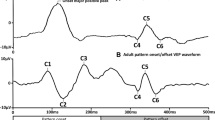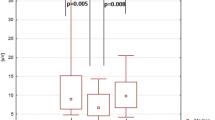Abstract
Compression of visual nerve fibres generally markedly increases the latency times of visually evoked occipital responses. If a visual field defect in optic disc drusen is caused by compression of nerve fibres, delayed responses would be expected in this condition too.
Examination of 23 patients (43 eyes) with optic disc drusen revealed that even the cases with serious field defects showed no marked delay in the pattern responses. As a consequence, examination of pattern responses is of no value in predicting progressive visual damage in patients with drusen.
As to an understanding of the cause of the field defects, the normal pattern responses exclude direct mechanical compression on the nerve fibres by drusen. More likely they are due to a circulatory disturbance in the small vessels, which in its turn may even be caused by gentle compression by the drusen.
Similar content being viewed by others
References
Cohen, D.N. Drusen of the optic disc and the development of field defects. Arch. Ophthal. 85: 224–226 (1971).
Erkkilä, H. The central vascular pattern of the eyeground in children with drusen of the optic disk. Graefes Arch. Ophthal. 199: 1–10 (1976).
Friedman, A.H., Beckerman, B., Gold, D.H., Walsh, J.B. & Gartner, S. Drusen of the optic disc. Surv. Ophthal. 21: 375–390 (1977).
Halliday, A.M., Halliday, E., Kriss, A., McDonald, W.I. & Mushin, J. The pattern evoked potentials in compression of the anterior visual pathways. Brain 99: 357–374 (1976).
Huber, C. & Wagner, T. Electrophysiological evidence for glaucornatous lesions in the optic nerve. Ophthal. Res. 10: 22–29 (1978).
Lorentzen, S.E. Drusen of the optic disc: A clinical and genetic study. Acta Ophthal. Suppl. 90: 1–19 (1966).
Sanders, T.E., Gay, A.J., & Newman, M. Hemorrhagic complications of drusen of the optic disk. Amer. J. Ophthal. 71: 204–217 (1971).
Seitz, R.: Die intraokularen Drusen. Klin. Mbl. Augenheilk. 152: 203–211 (1968).
Spencer, W.H.: Drusen of the optic disk and aberrant axoplasmic transport. Amer. J. Ophthal. 85: 1–12 (1978).
Walsh, F.B. & Hoyt, W.F. Clinical Neuro-Ophthalmology. Williams & Wilkins, Baltimore, p. 673–679 (1969).
Wise, G.N., Henkind, P. & Alterman, M. Optic disc drusen and subretinal hemorrhage. Trans. Amer. Acad. Ophthal. Otolaryng. 78: 212–219 (1974).
Author information
Authors and Affiliations
Rights and permissions
About this article
Cite this article
Brudet-Wickel, C.L.M., Van Lith, G.H.M. & Graniewski-Wijnands, H.S. Drusen of the optic disc and occipital transient pattern reversal responses. Doc Ophthalmol 50, 243–248 (1981). https://doi.org/10.1007/BF00158005
Issue Date:
DOI: https://doi.org/10.1007/BF00158005




